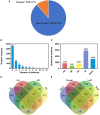Genome-Wide Analysis of Light-Regulated Alternative Splicing in Artemisia annua L
- PMID: 34659300
- PMCID: PMC8511310
- DOI: 10.3389/fpls.2021.733505
Genome-Wide Analysis of Light-Regulated Alternative Splicing in Artemisia annua L
Abstract
Artemisinin is currently the most effective ingredient in the treatment of malaria, which is thus of great significance to study the genetic regulation of Artemisia annua. Alternative splicing (AS) is a regulatory process that increases the complexity of transcriptome and proteome. The most common mechanism of alternative splicing (AS) in plant is intron retention (IR). However, little is known about whether the IR isoforms produced by light play roles in regulating biosynthetic pathways. In this work we would explore how the level of AS in A. annua responds to light regulation. We obtained a new dataset of AS by analyzing full-length transcripts using both Illumina- and single molecule real-time (SMRT)-based RNA-seq as well as analyzing AS on various tissues. A total of 5,854 IR isoforms were identified, with IR accounting for the highest proportion (48.48%), affirming that IR is the most common mechanism of AS. We found that the number of up-regulated IR isoforms (1534/1378, blue and red light, respectively) was more than twice that of down-regulated (636/682) after treatment of blue or red light. In the artemisinin biosynthetic pathway, 10 genes produced 16 differentially expressed IR isoforms. This work demonstrated that the differential expression of IR isoforms induced by light has the potential to regulate sesquiterpenoid biosynthesis. This study also provides high accuracy full-length transcripts, which can be a valuable genetic resource for further research of A. annua, including areas of development, breeding, and biosynthesis of active compounds.
Keywords: Artemisia annua; alternative splicing; artemisinin; intron retention; light-regulated; single molecule real-time (SMRT) sequencing.
Copyright © 2021 Ma, Gao, Zhang, Sun, Yin, Wu, Zhang, Xu, Wei, Su, Shi, Ding, Yuan, Dong, Leng, Xiang and Chen.
Conflict of interest statement
YYS and GD were employed by the Amway (China) Botanical R&D Center. The remaining authors declare that the research was conducted in the absence of any commercial or financial relationships that could be construed as a potential conflict of interest.
Figures




Similar articles
-
Transcriptome analyses revealed the ultraviolet B irradiation and phytohormone gibberellins coordinately promoted the accumulation of artemisinin in Artemisia annua L.Chin Med. 2020 Jul 1;15:67. doi: 10.1186/s13020-020-00344-8. eCollection 2020. Chin Med. 2020. PMID: 32625243 Free PMC article.
-
Transcriptome Analysis of Genes Associated with the Artemisinin Biosynthesis by Jasmonic Acid Treatment under the Light in Artemisia annua.Front Plant Sci. 2017 Jun 8;8:971. doi: 10.3389/fpls.2017.00971. eCollection 2017. Front Plant Sci. 2017. PMID: 28642777 Free PMC article.
-
[Mechanism of high temperature promoting artemisinin biosynthesis in Artemisia annua].Zhongguo Zhong Yao Za Zhi. 2018 Oct;43(20):4169-4176. doi: 10.19540/j.cnki.cjcmm.20180726.011. Zhongguo Zhong Yao Za Zhi. 2018. PMID: 30486546 Chinese.
-
[Statues and research strategy of molecular breeding in Artemisia annua].Zhongguo Zhong Yao Za Zhi. 2018 Aug;43(15):3041-3050. doi: 10.19540/j.cnki.cjcmm.2018.0093. Zhongguo Zhong Yao Za Zhi. 2018. PMID: 30200697 Review. Chinese.
-
[Molecular mechanism of artemisinin biosynthesis and regulation in Artemisia annua].Zhongguo Zhong Yao Za Zhi. 2017 Jan;42(1):10-19. doi: 10.19540/j.cnki.cjcmm.20161222.019. Zhongguo Zhong Yao Za Zhi. 2017. PMID: 28945019 Review. Chinese.
Cited by
-
A Global Analysis of Alternative Splicing of Dichocarpum Medicinal Plants, Ranunculales.Curr Genomics. 2022 Jul 5;23(3):207-216. doi: 10.2174/1389202923666220527112929. Curr Genomics. 2022. PMID: 36777007 Free PMC article.
-
Probing of plant transcriptomes reveals the hidden genetic diversity of the family Secoviridae.Arch Virol. 2024 Jun 20;169(7):150. doi: 10.1007/s00705-024-06076-6. Arch Virol. 2024. PMID: 38898334
-
Ti3C2(OH)x-assisted LDI-TOF-MS for the rapid analysis of natural small molecules.Anal Bioanal Chem. 2022 Dec;414(29-30):8447-8461. doi: 10.1007/s00216-022-04382-z. Epub 2022 Nov 3. Anal Bioanal Chem. 2022. PMID: 36323886
-
Relevance and regulation of alternative splicing in plant secondary metabolism: current understanding and future directions.Hortic Res. 2024 Jul 2;11(8):uhae173. doi: 10.1093/hr/uhae173. eCollection 2024 Aug. Hortic Res. 2024. PMID: 39135731 Free PMC article. Review.
-
AaMYB121, a Novel R2-MYB-like Transcription Factor, Regulates Artemisinin Biosynthesis in Artemisia annua.Int J Mol Sci. 2025 Mar 9;26(6):2441. doi: 10.3390/ijms26062441. Int J Mol Sci. 2025. PMID: 40141085 Free PMC article.
References
LinkOut - more resources
Full Text Sources
Research Materials

